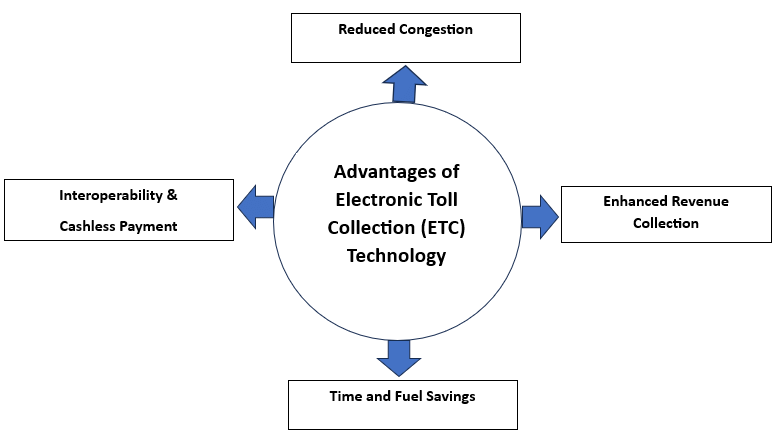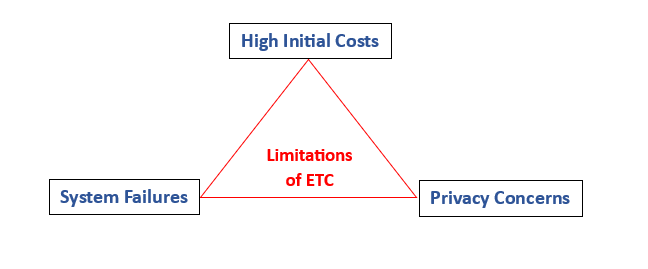UPSC Mains Previous Year Questions 2024: GS3 Science & Technology | Science & Technology for UPSC CSE PDF Download
Q1: What is the technology being employed for electronic toll collection on highways? What are its advantages and limitations? What are the proposed changes that will make this process seamless? Would this transition carry any potential hazards? (Answer in 150 words)
Ans:
Introduction
Electronic toll collection on highways utilizes advanced technologies such as FASTag and Global Navigation Satellite Systems (GNSS) to automate and streamline toll payments. Estimates suggest that transitioning entirely to FASTag-based toll systems in India could save approximately ₹12,000 crore annually through reduced fuel consumption and man-hours.
Technologies Employed
- RFID (Radio Frequency Identification): Devices like FASTag enable automatic toll payment by reading tags affixed to vehicles as they pass through toll plazas.
- GPS (Global Positioning System): Monitors vehicle locations in real-time to calculate tolls based on distance traveled.
- ANPR (Automatic Number Plate Recognition): Utilizes cameras to capture vehicle registration numbers, allowing toll payments without the need for stopping.


- Satellite-Based Toll Collection: GNSS-enabled tolling facilitates toll payments without requiring vehicles to stop at booths.
- On-Board Units (OBUs): Vehicles will feature non-transferable OBUs, potentially pre-installed in new vehicles, much like current FAS Tag systems.
- Multi-Lane Free Flow (MLFF): Integrates RFID, ANPR, and GNSS to enable toll collection while vehicles remain in motion.
- Unified Toll Aggregation System: Establishes a national platform to simplify toll payments across states and highways.
Challenges and Risks
Potential challenges include cybersecurity vulnerabilities, such as hacking and data breaches, and disparities for low-income groups who may lack access to digital payment tools. Additionally, technical failures and infrastructure limitations could disrupt operations.
Conclusion
The adoption of electronic toll collection systems brings significant advantages, such as reduced congestion and faster transactions. However, addressing challenges like cybersecurity threats, infrastructure gaps, and ensuring equitable access is vital for a smooth and fair transition to these modern technologies.
Q2: What are asteroids? How real is the threat of them causing extinction of life? What strategies have been developed to prevent such a catastrophe? (Answer in 250 words)
Ans:
Introduction
Asteroids, also known as minor planets, are rocky remnants from the early solar system, formed about 4.6 billion years ago. Most of them are located in the main asteroid belt, which lies between Mars and Jupiter.
Body
Threats Posed by Asteroids
- Historical Impact: A massive asteroid impact occurred around 66 million years ago, contributing to the extinction of the dinosaurs and many other species.
- Localized Damage: Smaller asteroids have the potential to cause significant local devastation, such as tsunamis, wildfires, and atmospheric disturbances.
- Recent Events: The Chelyabinsk meteorite explosion over Russia in 2013 caused widespread damage and injuries. Similarly, the Tunguska event in 1908, an enormous explosion in Siberia, remains the largest documented impact event in modern history.
- Space Debris: A shattered asteroid could create dangerous debris in space, posing risks to satellites, space stations, and future space missions.
Strategies to Prevent an Asteroid Impact
- Asteroid Detection and Monitoring: Space agencies like NASA and ESA continuously track and catalog asteroids that may threaten Earth. Using both ground-based and space-based telescopes, such as NASA’s NEOWISE mission, they assess the potential risks posed by near-Earth objects (NEOs).
Deflection Techniques
- Kinetic Impactor: NASA’s Double Asteroid Redirection Test (DART) mission is a pioneering effort to deflect asteroids by colliding a spacecraft with one.
- Gravity Tractor: This approach involves using the gravitational pull of a spacecraft to gently alter an asteroid’s trajectory over time, without direct contact.
- Nuclear Detonation: In extreme cases, detonating a nuclear device near an asteroid could either break it apart or push it off course, though this method carries significant risks of fragmentation.
- Futuristic Approaches: India’s ISRO plans to study an asteroid in 2029 to advance planetary defense, potentially joining forces with the Apophis asteroid mission, a collaboration between JAXA, ESA, and NASA.
Conclusion
Although asteroids present a serious threat, advances in detection, deflection technologies, and international collaboration are strengthening planetary defense systems. These efforts are improving our preparedness and may eventually allow us to tap into the resources asteroids offer.
Q3: Social media and encrypting messaging services pose a serious security challenge. What measures have been adopted at various levels to address the security implications of social media? Also suggest any other remedies to address the problem. (Answer in 250 words)
Ans:
Introduction
The rise of social media and encrypted messaging services has transformed communication in India, becoming crucial tools for sharing information and connecting people. However, these platforms also introduce significant risks to national security, public safety, and social cohesion. Issues such as the spread of misinformation and the facilitation of criminal activities have turned digital spaces into new areas of security concern.
Security Challenges of Social Media and Encrypted Messaging Services
- Misinformation: Social media platforms are often used to spread false information, fueling societal unrest. For example, manipulated content during the 2022 Russia-Ukraine conflict flooded various platforms.
- Radicalization: Extremist groups use encrypted apps to recruit followers. A notable case is ISIS leveraging Telegram for its operations.
- Cybercrime: These platforms enable a variety of crimes, including scams and identity theft. A prominent example is the 2023 deep fake scams, which involved using celebrity faces.
- Data Privacy: There are growing concerns about the misuse of personal data. The 2018 Cambridge Analytica scandal raised awareness about the risks of data exploitation.
- Digital Warfare: Social media has been used to spread disinformation to influence political events, such as Russia's manipulation of the 2020 U.S. elections.
Measures to Address Social Media Security Challenges
- IT Act 2000: This legislation governs online communication in India. Sections 69A and 79(1) allow the government to block harmful content and provide conditional immunity to intermediaries. In 2020, India banned 59 Chinese apps for security reasons.
- IT Rules 2021: These rules mandate platforms to moderate content and notify users about their privacy policies. Twitter, for instance, faced compliance challenges in 2021.
- Grievance Officers: Social media platforms are required to appoint grievance officers to handle user complaints. Meta appointed Spoorthi Priya to this role in 2022.
- Fact-Checking: The government has the authority to flag and demand the removal of false content, a rule under review by the Supreme Court in 2023.
Other Remedies
- Additional measures could include improving cybersecurity infrastructure, increasing public awareness through digital literacy programs, and ensuring transparency in data handling.
- Collaboration between tech companies, government agencies, and civil society will be essential to effectively address the security challenges posed by social media.
Conclusion
A combination of technological solutions, enhanced digital literacy, and cooperation between various stakeholders can help India create a safer online environment. It is crucial to find a balance between ensuring national security and protecting individuals' privacy, fostering a secure and dynamic digital ecosystem for all citizens.
|
114 videos|427 docs|209 tests
|
FAQs on UPSC Mains Previous Year Questions 2024: GS3 Science & Technology - Science & Technology for UPSC CSE
| 1. What are the key areas covered under Science and Technology in UPSC GS3? |  |
| 2. How does the UPSC evaluate candidates on Science and Technology topics in the Mains exam? |  |
| 3. What are some recent technological advancements that UPSC might focus on in GS3? |  |
| 4. How important is current affairs in the Science and Technology section of the UPSC Mains exam? |  |
| 5. What strategies can candidates adopt to prepare for the Science and Technology section of UPSC GS3? |  |
|
114 videos|427 docs|209 tests
|

















